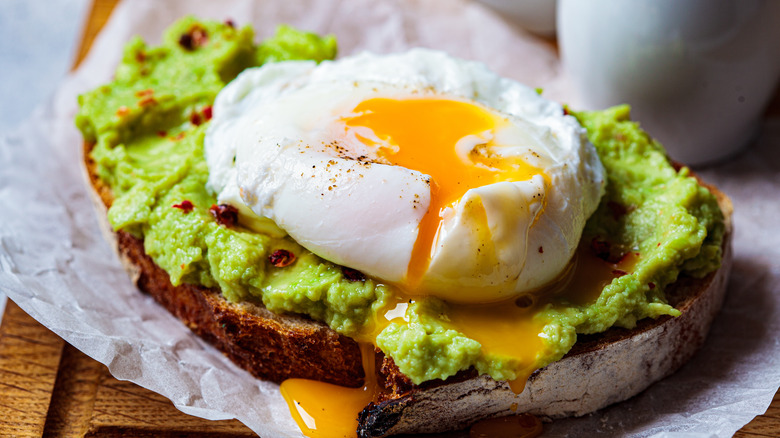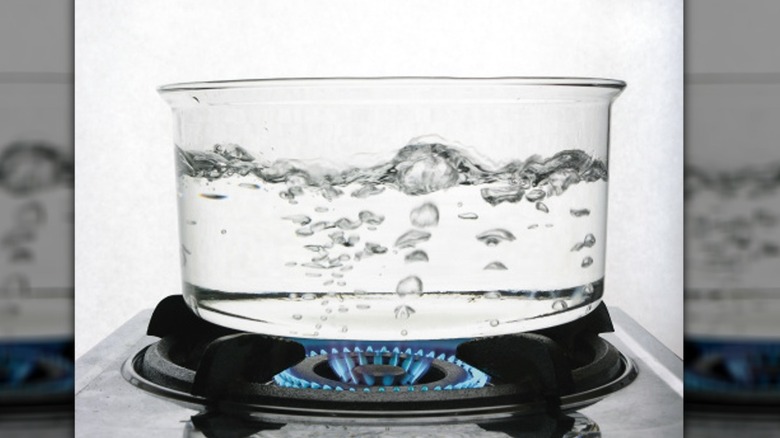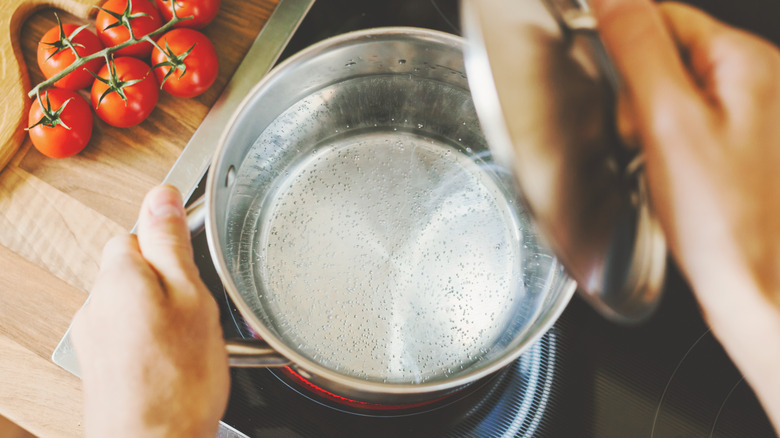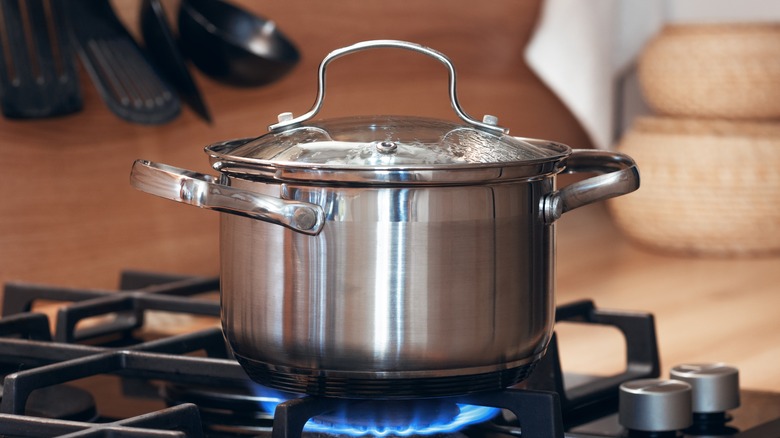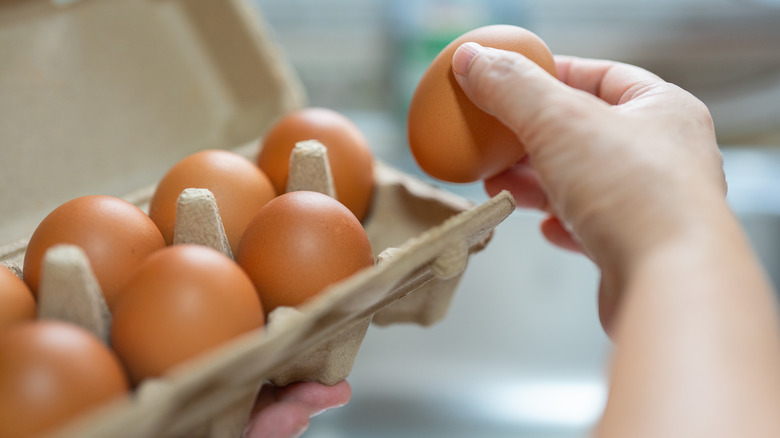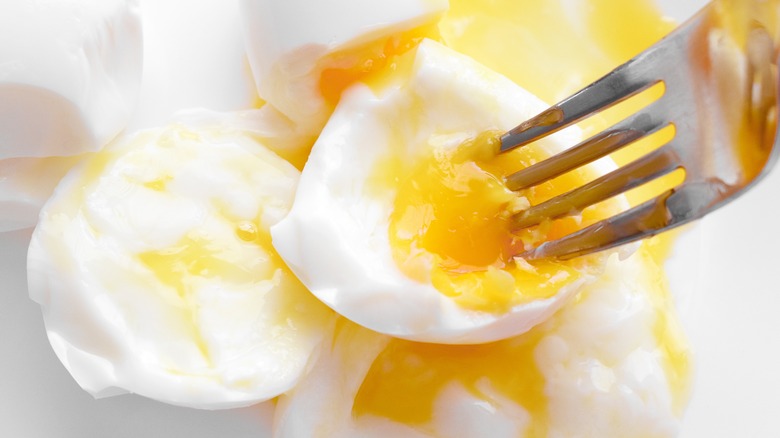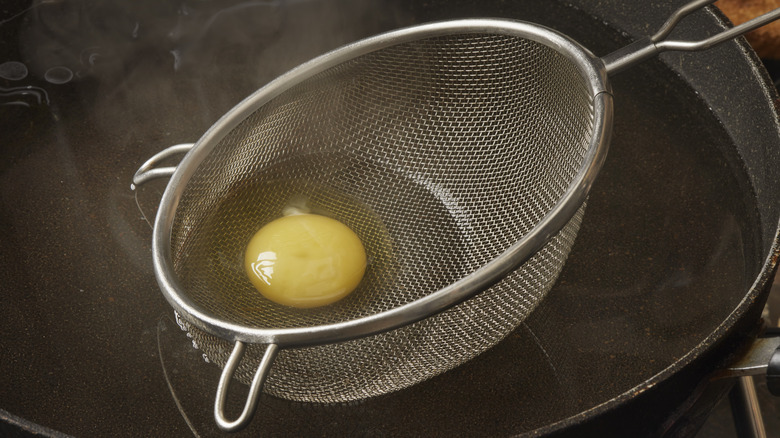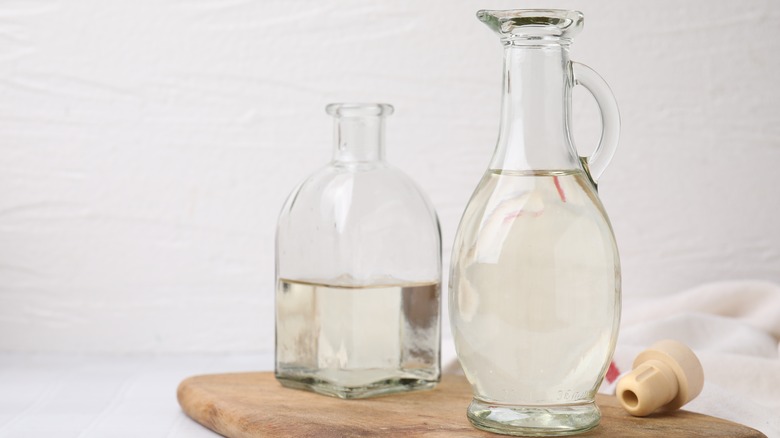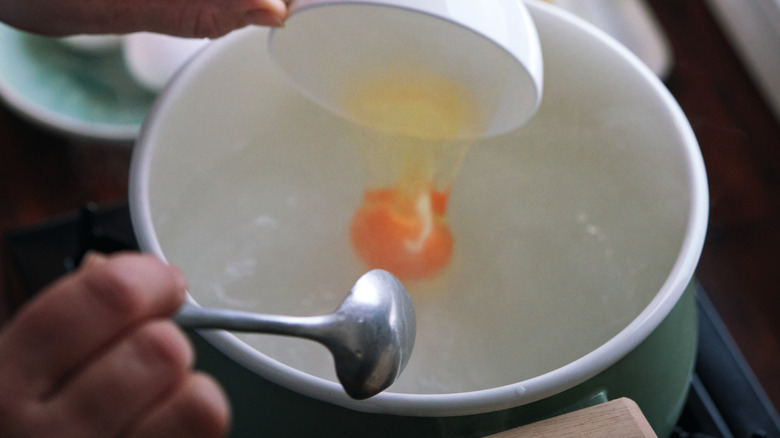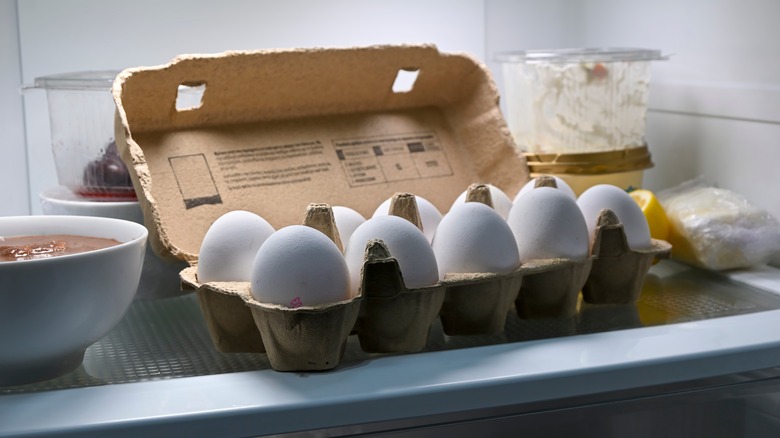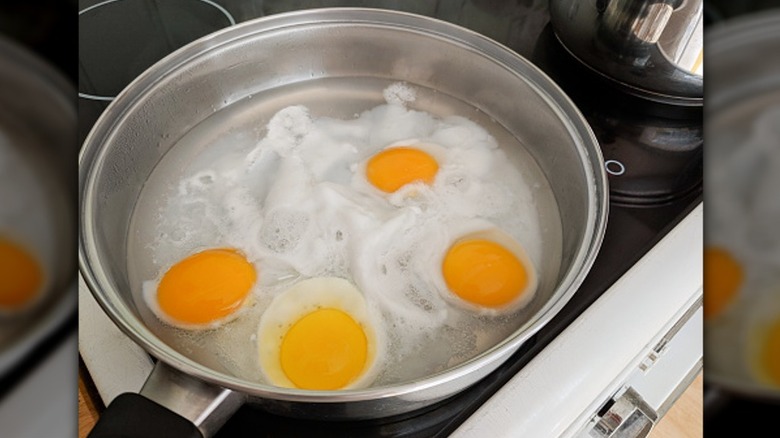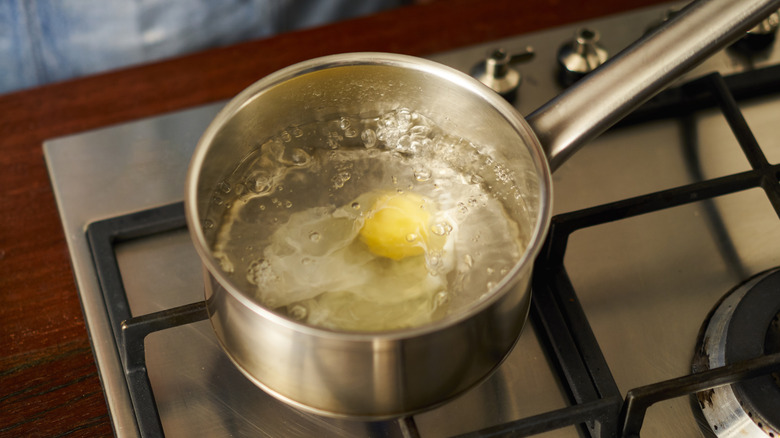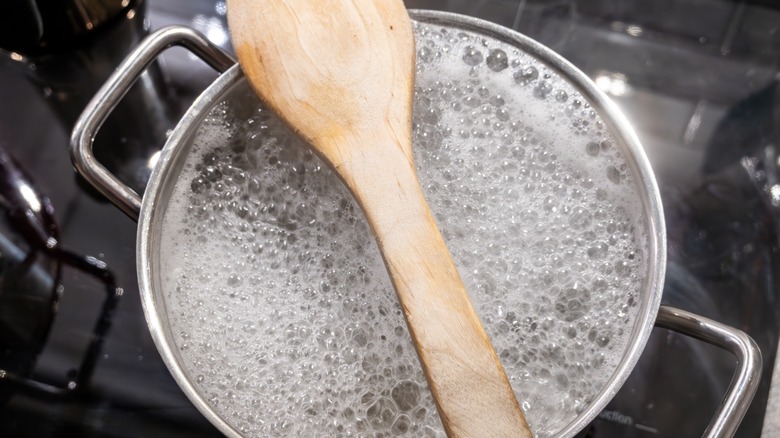12 Mistakes That Are Killing Your Poached Eggs
Poached eggs are a delicious way to add some protein to your breakfast, especially when paired with hollandaise and ham in a scrumptious eggs Benedict. You can also enjoy poached eggs on everything from avocado toast to cacio e pepe eggs, a favorite of Bobby Flay. But they're notoriously difficult to get right because they are so delicate and picky when it comes to temperature, speed, and technique. Wispy, feathered whites and broken yolks are two of the most common problems. Fortunately, with a little bit of practice, you can master poached eggs in record time.
If you're attempting this style of egg, make sure to avoid one of these key mistakes, many of which require some prep work before you even start poaching the egg. Because this style of egg cooks quickly, you need to be prepared with the right tools and be ready to remove the egg as soon as it's done. Additionally, there are some steps that you can take to prepare the water and crack the egg to maximize your chances of getting the perfect poached egg.
Don't boil your water too hot
If your water is boiling too rapidly, it can cause the egg to break apart as it cooks. Boiling water causes the delicate egg whites to move around too quickly. You'll be left with wisps of egg rather than a uniform one. The yolks can also cook too quickly, which hardens your yolk. A perfect poached egg has firm whites and a runny yolk.
Instead of using boiling water, aim for a gentle simmer or what some chefs call a "rolling simmer." This means that the bubbles at the bottom of the pot is slower and smoother than a full boil. A simmer is the perfect temperature for poached eggs because it's hot enough to cook them but doesn't rock the egg around in the water uncontrollably. When you see the bubbles start to form around the edges of your pot, watch it closely and turn down the heat if necessary to get the right simmer. Don't rush this process because the water temperature is one of the most important factors when it comes to getting an intact poached egg.
Don't keep your water too cold
The trick to getting a uniform poached egg is that the egg stays in the middle of the water as it cooks. If it touches the bottom or sides, it will not cook evenly and is more likely to break apart. When the water is too cold, there isn't any movement and the egg sinks right to the bottom uncooked.
If the water is too cold, the yolk and whites are also more likely to separate before they have a chance to cook. Aim for water that is just about simmering since it will cool slightly when the eggs are dropped into it. If you put a cold egg into the water, some of the heat will transfer to the egg and the water will cool down. Try to account for the balance of the water temperature and the egg temperature when finding the right sweet spot. If your eggs are colder, let the water get a little bit hotter before you try poaching your egg.
Select the right pot
Just like the water's movement is important factor in keeping the egg in the right position, the size of the pot also plays a role. Your egg needs enough space to move around in the water; thus, a pot that is too small or shallow will cause the egg to bounce around like a pinball machine. A pot that's too large will be difficult to work with, especially when it's time to get the egg out of the water. If it's too narrow, the egg might end up hitting the sides and sticking. Either way, the result is a poached egg that is not cooked evenly or even one that breaks apart in the pot. Ideally, your pot should be filled with about 3-4 inches of water.
A shallow pot also holds less water and heats faster. This might mean that a slight error in temperature can create disastrous results before you even realize it. On the other hand, a pot that's too big will lose heat quickly and will be hard to keep hot enough. The ideal pot for a single poached egg is a deep saucepan that is roughly the size of your burner. A shallow pot will work as long as the egg has enough water to move around without sticking to the bottom. But the poached egg will likely turn out more oval-shaped rather than a sphere.
Stick with fresh eggs
Fresh eggs have the most stable whites, which is key when it comes to poaching an egg. Runny whites from older eggs will not stay intact when they hit the boiling water. You'll be left with delicate pieces coming off the side of your poached egg. Eggs that are extremely runny might not even come together at all, leaving you with a cloud of congealed egg whites and a hard-boiled yolk.
Instead, use an egg that was laid fresh that day. But if you don't have access to your own flock of chickens or just don't know when the eggs were laid, use eggs that you brought home from the grocery store within the last couple of days. Eggs will last between three and five weeks when refrigerated but you should always go by the sell-by or expiration date on the carton when deciding whether or not to use your eggs. For poached eggs, fresher is always better.
Don't overcook your eggs
It doesn't take long to get a great poached egg when you have the right water temperature and space for the egg to move around. If you're not paying attention, your egg can go from delicious to rubbery within seconds. The perfect poached egg has a yolk that ranges from runny to soft, depending on your preference. The white should be firm with just a little bit of give. But an overcooked poached egg has a firm yolk and rubbery consistency overall.
Cook for about 2-3 minutes in simmering water for the perfect amount of doneness. The yolk is the last part to cook but any more than 5 minutes in simmering water will create a hard yolk. The exact amount of time does come down to personal preference, so don't be afraid to try it a few times to decide what you like. It's also important to keep your water at a consistent temperature so that your expected cooking time works the same everytime you make a poached egg.
Crack the egg into a bowl
It's best to crack your egg into a small bowl before putting it in the water. This allows you to catch any pieces of shell that might have accidentally fallen in. You can also strain your egg at this step to remove any small pieces of shell and excess liquid. Removing these with a strainer is a great way to prep the egg. It also ensures that your egg is ready when the water reaches the ideal temperature, reduces the splash when you add the egg, and gives you better control of each step. The egg begins cooking as soon as it goes in the water and the first few seconds are critical to getting the white wrapped around the yolk in a nice, compact shape.
Cracking a cold egg into a ramekin can also help it reach room temperature faster. If it's a stainless steel bowl, you can place it in a warm water bath by putting it into a larger bowl and adding warm water around it. Let the bowl rest in the bath to warm up the egg but make sure the water doesn't spill over into the smaller egg bowl.
Don't omit vinegar
Vinegar isn't required to poach eggs but it will increase your chances of success, especially when it comes to the shape of your egg. Adding vinegar to your water is highly recommended, as vinegar contains acid that will denature the egg white proteins. This begins the cooking process faster than hot water alone and firms up the outermost part of the white. Rather than turn into trailing bits in the water, the egg white stays together around the rest of the egg. Note that adding a splash of vinegar might change the temperature of your water if it's already simmering. Instead, add vinegar to the water before it comes to the desired temperature. If you have to add it later, give yourself a little bit more time to let the water-vinegar combo come back to a simmer before adding your egg.
You can add vinegar directly to the water or even try a vinegar soak before putting them in to poach. Adding vinegar won't impact the final taste of your egg. Use white vinegar to keep it from turning the water or the egg into different colors. You can also use apple cider vinegar or rice wine vinegar.
Use the right tools
You have to be careful with delicate poached eggs when you take them out of the hot water, which is why having the right tools on hand is key. Even if you have a perfectly poached egg, handling it roughly can leave you with a gooey mess. Try this TikTok tip for the best poached eggs, which involves using a soup ladle to keep the egg intact. A slotted spoon also works well and drains any excess water clinging to the poached egg. An egg timer can be helpful to have on hand to make sure that you don't forget to take the egg out when it's done.
Make sure you have your tools on hand before you even begin cooking your egg. Once your egg is ready to come out of the water, you don't have a lot of time before it ends up overcooked. Gather everything that you might need while your water comes to temperature so that you are ready to poach your egg, which includes taking it out of the hot water.
Don't poach cold eggs
Water temperature is critical when it comes to poaching eggs, which is why the process has a reputation for being difficult. But your egg temperature is also important and it can turn the perfect rolling simmer into still water when you add the egg. Don't make one of these mistakes when poaching eggs or it will impact the water temperature, which might result in water that is too cold and eggs that don't come together. Cracking cold eggs fresh from the fridge into hot water will bring the temperature of the water down and impact the cooking process.
Instead, let your eggs sit at room temperature for around 30 minutes before poaching them but no more than two hours, and less if the temperature outside is above 90 degrees Fahrenheit, according to the USDA. If you want to get your eggs to room temperature even faster, put them in a warm water bath for 5-10 minutes. Just make sure that the water is tepid and not hot or they might cook.
Don't cook too many eggs
To correctly poach an egg, you need to let it swirl in the water to create a uniform shape, simple enough if you're poaching one egg. But once you add multiple eggs in the same pot, it becomes a bit crowded. This is because they don't have any room to move around and will cook unevenly. They're also more likely to stick to the sides and bottom of the pot, which can happen when they brush up against each other during the cooking process. When you're trying to remove eggs from the pot, it's too easy to bump into other eggs still poaching, which can result in broken yolks.
If you do need to cook poached eggs for a large group, work in smaller batches. This also lets you have more control over the eggs as they cook. You can carefully place your poached eggs on a plate when they are done. There are many other methods for poaching eggs, such as using an air fryer or a sous vide machine, to make eggs faster and in larger quantities.
Don't stir too much
You want your egg to move around in the water as it poaches but too much stirring can cause the yolk to break. If it breaks in the pot, you'll end up with a yolky mess that resembles watery scrambled eggs. Stirring the water with a spatula or spoon can also pull the whites away from the center as they cook, resulting in feathery poached eggs that doesn't look as nice.
It's better to stir before rather than after you add the egg. Instead of stirring, rely on the movement of the water to keep the egg suspended and away from the edges. You can also give the water a gentle stir before you drop the egg in to create that movement. The right amount of simmering will also keep things moving when the egg is added. If you do need to move the egg around, keep your stirring to the edges just enough to move the water and only graze the egg if absolutely necessary.
Swirl the water without the egg
Swirling the water before slipping the egg in is one of the most important steps to creating perfect poached eggs and the step that will keep your egg together as it poaches. Give your boiling water a little stir with a wooden spoon, a spatula or a fork before dropping the egg into it to create a little swirl. This creates movement that the egg will follow as it poaches, keeping it intact and guiding the white to wrap around the yolk in the center. This is a great trick to use with vinegar to create a fantastic base for your egg when it's ready to poach.
It's important to do this before you add the egg to the water. If you try to add a swirl after the egg is in, it might create a vortex above the egg, which can sink to the bottom. Not only does this make it ineffective, but it can also result in an egg that sticks to the bottom of the pot. To remove the egg, you'll likely have to break it apart and end up with a broken yolk in the water.
